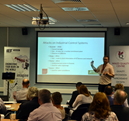Cutting the Carbon Footprint
These days if someone asks you if you know how big your footprint is, they may not necessarily be asking about your shoe size. Chances are they might be asking about the size of your "carbon footprint" instead. Determining carbon footprint and then looking for ways to reduce it is gaining popularity among people wanting to decrease their negative impact on the environment.
There are many people though who are still asking, "Just what is my carbon footprint and why on earth should I care how big it is?"
If you are one of them or even if you are just looking for some great ideas on reducing yours, SMECluster provides some great resources. We should all recognise that individual action alone won’t cut it. The problem of global warming must be confronted at every level of society, from business practices to government policy.
In short, your carbon footprint is basically the sum total of all your actions and decisions and the impact they have on the environment through carbon emissions. Businesses are under scrutiny all over the world and legislative measures are to be pushed through to force a greener economy. How you work, purchase, sell and travel all impact the size of the footprint and SMECluster is here to help you identify the weaknesses and comply with policy.
A carbon footprint measures the total greenhouse gas emissions caused directly and indirectly by a person, organisation, event or product.
A carbon footprint is measured in tonnes of carbon dioxide equivalent (tCO2e). The carbon dioxide equivalent (CO2e) allows the different greenhouse gases to be compared on a like-for-like basis relative to one unit of CO2. CO2e is calculated by multiplying the emissions of each of the six greenhouse gases by its 100 year global warming potential (GWP).
A carbon footprint considers all six of the Kyoto Protocol greenhouse gases: Carbon dioxide (CO2), Methane (CH4), Nitrous oxide (N2O), Hydrofluorocarbons (HFCs), Perfluorocarbons (PFCs) and Sulphur hexafluoride (SF6).
Types of carbon footprinting
The main types of carbon footprint for organisations are:
- Organisational carbon footprint
Emissions from all the activities across an organisation, including buildings' energy use, industrial processes and company vehicles.
- Value chain carbon footprint
Includes emissions which are outside an organisation's own operations (also known as Scope 3 emissions). This represents emissions from both suppliers and consumers, including all use and end of life emissions.
- Product carbon footprint
Emissions over the whole life of a product or service, from the extraction of raw materials and manufacturing right through to its use and final reuse, recycling or disposal.
Calculate your carbon footprint
SMECluster will give your business a carbon footprinting guide to explain what is included in organisational and product footprints, how you can measure and communicate them, and the benefits of doing so. We also set out the specific steps you need to take to calculate your carbon footprint(s), and some of the key things to consider if you do.
For further support, contact us to find out more about carbon footprinting services including Footprint measurement (including carbon footprinting software) and Footprint certification.

SMECluster is the trading name of Sematronix Limited and finally the Clustering concept is becoming a reality.
© Copyright Control2K 2025. All rights reserved. SME Cluster.







